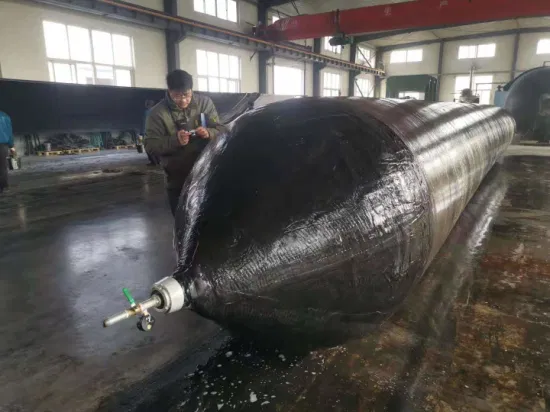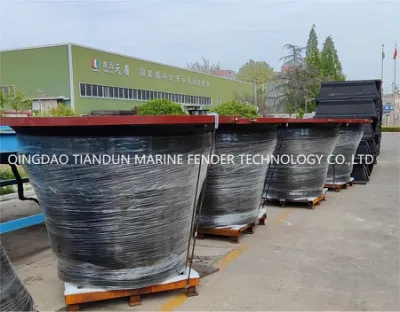
Pneumatic Fender Yokohama Type Submarine Fender Defenses for Sts
Description
Basic Info.
| Model NO. | pneumatic fender |
| Certificates | BV, CCS, ABS, Lr |
| Type | Sling Type/Net Type |
| Thickness | More Than 18mm |
| Accessories | Free |
| Transport Package | Bracket |
| Specification | Dia2.0mxEL3.5m |
| Trademark | Evergreen |
| Origin | China |
| HS Code | 40169400 |
| Production Capacity | 300PCS/Month |
Product Description
Pneumatic FenderYokohama Type Submarine Fender defenses for STS
Performace table for P50 & P80 Pneumatic Fenders
| Nominal size mm | Pneumatic 50 Guaranteed energy absorption (KN.M) | Pneumatic 50 Reaction force at GEA deflection (KN) | Pneumatic 50 Hull pressure at GEA deflection (KN) | Pneumatic 80 Guaranteed energy absorption (KN.M) | Pneumatic 80 Reactionforce at GEA deflection (KN) | Pneumatic 80 Hull pressureat GEA deflection (KN) |
| Dia x Length | 60% deflection | Tolerance ±10% | 60% deflection | Tolerance ±10% | ||
| 500×1000 | 6 | 64 | 132 | 8 | 85 | 174 |
| 600×1000 | 8 | 74 | 126 | 11 | 98 | 166 |
| 700×1500 | 17 | 137 | 135 | 24 | 180 | 177 |
| 1000×1500 | 32 | 182 | 122 | 45 | 239 | 160 |
| 1000×2000 | 45 | 257 | 132 | 63 | 338 | 174 |
| 1200×2000 | 63 | 297 | 126 | 88 | 390 | 166 |
| 1350×2500 | 102 | 427 | 130 | 142 | 561 | 170 |
| 1500×3000 | 153 | 579 | 132 | 214 | 761 | 174 |
| 1700×3000 | 191 | 639 | 128 | 267 | 840 | 168 |
| 2000×3500 | 308 | 875 | 128 | 430 | 1150 | 168 |
| 2500×5000 | 663 | 1381 | 137 | 925 | 1815 | 180 |
| 2500×5500 | 943 | 2019 | 148 | 1317 | 2653 | 195 |
| 3300×4500 | 1175 | 1884 | 130 | 1640 | 2476 | 171 |
| 3300×6500 | 1814 | 3015 | 146 | 2532 | 3961 | 191 |
Remarks:
- Initial pressure 0.05Mpa.
- Tolerance between Reation force & Energy absorption: ±10%
- Weight Tolerance: ±10%
- Special dimensions can be customized.
- All the Fittings are Hot-galvanized and Antirust Treatment.
Details from ISO 17357
3.1 floating pneumatic rubber fender
fender which is made of synthetic-cord-reinforced rubber sheet with compressed air inside to enable it to float on the water and work as a shock absorber between two ships, or between ships and berthing structures when they come alongside each other on the waterNOTE The fenders have sometimes been colloquially referred to as okohama fenders or Yokohama type fenders. These are examples of suitable products available commercially. This information is given for the convenience of users of this International Standard and does not constitute an endorsement by ISO of these products.3.2outer rubberrubber layer that covers the outside of the fender to protect the cord layers and the inner liner rubber from abrasion and other external forces
3.3inner rubberliner of a rubber membrane that seals the pressurized air inside the fender
3.4synthetic-tyre-cord layer for reinforcementlayer made of synthetic-tyre-cord fabric, which maintains the internal air pressure of the fender
NOTE As the main fibres of the synthetic-tyre-cord fabric are not braided like synthetic canvas fabric or synthetic belt fabric, there are advantages for its fatigue-resistance performance and pressure-holding performance. See annex A.3.5bead ringsteel ring which is placed at one end (or both ends) of the fender and holds the end of cord layers
3.6flange openingsteel flange, which is mounted on the fender, to which an air valve or safety valve can be adapted
3.7guaranteed energy absorptionenergy that the fender can absorb without permanent deformation or failure
3.8reaction forceforce produced by a fender reacting to a compressive force
NOTE The reactive force is equal to the force of the air pressure of the fender multiplied by the area of the fender in contact with the ship or berthing structure.3.9initial internal pressureair pressure at which an uncompressed fender operates
3.10endurable pressureinner pressure at which a fender bursts
3.11net-type fenderfender which is covered by a protection net consisting of either chain, wire or fibre and usually with tyres or rubber sleeves
3.12sling-type fenderfender which is designed to be used without a protection net
Prev: High Energy Absorption Marine Rubber Super Cone Dock Fender
Next: US Navy Specifications Yokohama Hydro Pneumatic Fenders for Submarine
Our Contact






